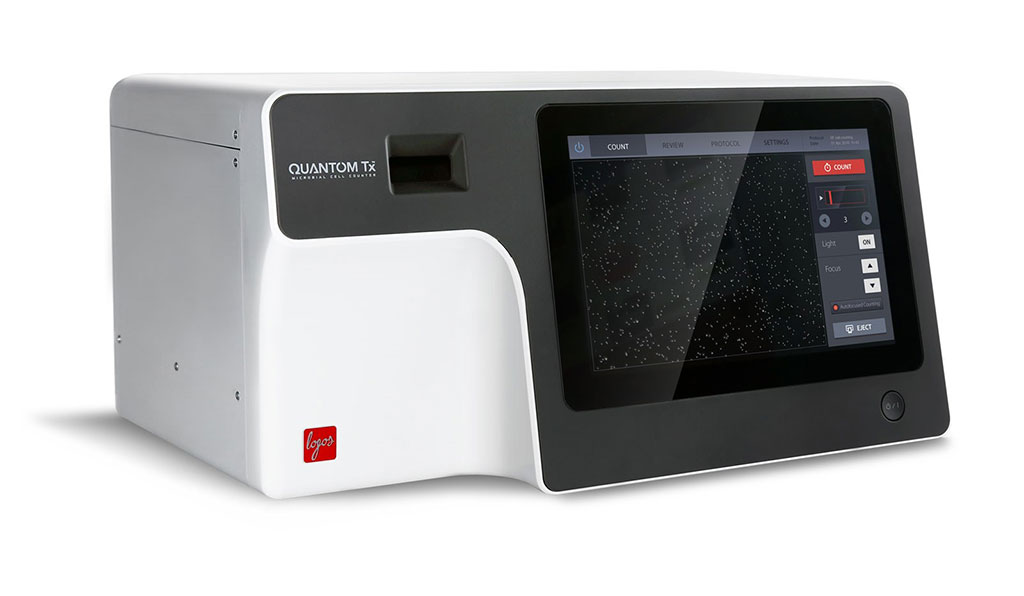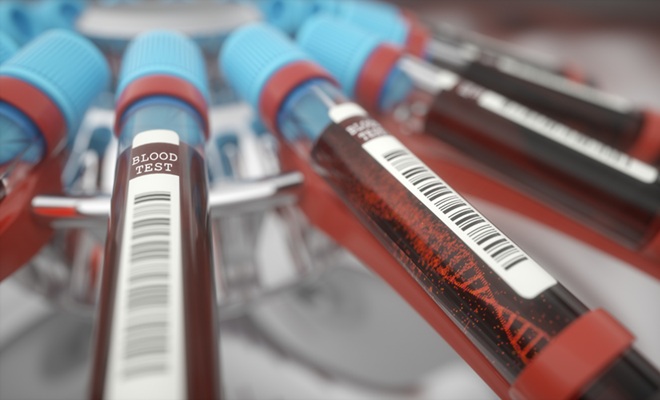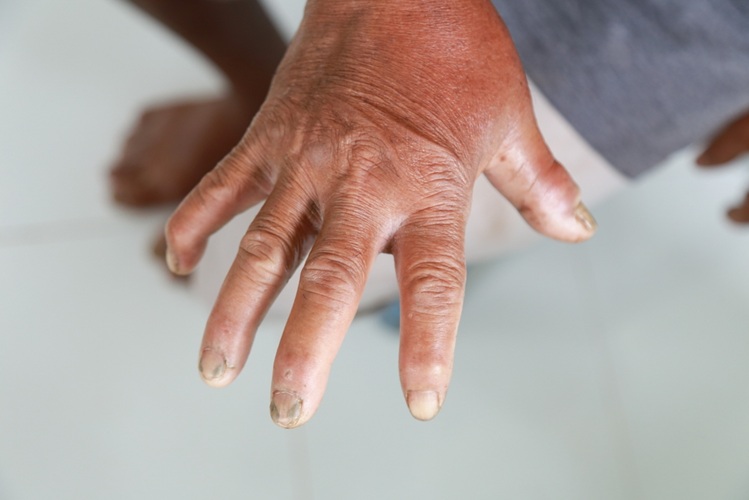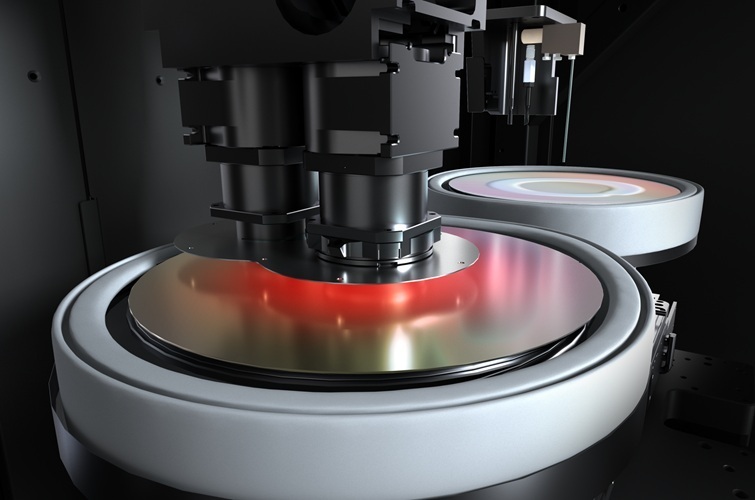Automated Fluorescent Microbial Cell Counter Detects Urinary Tract Infection
|
By LabMedica International staff writers Posted on 15 Jul 2020 |

Image: The QUANTOM Tx Microbial Cell Counter is an image-based, automated cell counter that can identify and count individual bacterial cells in minutes (Photo courtesy of Logos Biosystems).
Urinary tract infections (UTI) accounted for around 400,000 hospitalizations, resulting in an estimated cost burden of approximately USD 2.8 billion in the USA. Between 50% and 60% of adult women will have at least one UTI in their life, and close to 10% of postmenopausal women indicate that they had a UTI in the previous year.
A rapid urinalysis is usually conducted upon presentation with UTI‐related symptoms in patients. A rapid urinalysis screens the urine for ketones, proteins, reducing substances, red blood cells (RBC), white blood cells (WBC), nitrites, and pH levels outside the normal range (4.5 to 8.0). The most common pathogen associated with UTI globally is Escherichia coli.
Gastroenterologists and their associates at the Sinai Hospital (Baltimore, MD, USA) obtained clean‐catch urine samples from 10 healthy control subjects with a negative urinalysis result and 11 subjects with suspected UTI with a positive urinalysis and culture result for E. coli. Urine samples that received a positive result were plated onto blood agar and MacConkey medium for growth analysis. Urine samples were analyzed using the QUANTOM Tx Microbial Cell Counter (Logos Biosystems, Annandale, VA, USA) upon reception from the microbiology laboratory.
The scientists reported that the mean cellular concentration for the 11 E. coli‐positive samples was 1.01 × 108 cells/mL (range = 2.5 × 107–3.29 × 108 ± SD = 8.9 × 107). The average cellular concentration for the 10 control samples was 2.35 × 106 cells/mL (range = 9.42 × 105–5.93 × 106 ± SD = 1.56 × 106). The difference in cellular concentration between the E. coli‐positive and control groups was found to be statistically significant.
The authors concluded that the automated microbial cell counter represents a significant step toward high throughput, reproducible microbial cell observation, and quantification. A significant difference in cellular concentration was observed between E. coli‐positive UTI samples and controls measured with an automated microbial cell counter. Thus, automated microbial cell counters may serve important roles as preliminary screening tools in clinical diagnostic settings. The study was published on July 4, 2020 in the Journal of Clinical Laboratory Analysis.
Related Links:
Sinai Hospital
Logos Biosystems
A rapid urinalysis is usually conducted upon presentation with UTI‐related symptoms in patients. A rapid urinalysis screens the urine for ketones, proteins, reducing substances, red blood cells (RBC), white blood cells (WBC), nitrites, and pH levels outside the normal range (4.5 to 8.0). The most common pathogen associated with UTI globally is Escherichia coli.
Gastroenterologists and their associates at the Sinai Hospital (Baltimore, MD, USA) obtained clean‐catch urine samples from 10 healthy control subjects with a negative urinalysis result and 11 subjects with suspected UTI with a positive urinalysis and culture result for E. coli. Urine samples that received a positive result were plated onto blood agar and MacConkey medium for growth analysis. Urine samples were analyzed using the QUANTOM Tx Microbial Cell Counter (Logos Biosystems, Annandale, VA, USA) upon reception from the microbiology laboratory.
The scientists reported that the mean cellular concentration for the 11 E. coli‐positive samples was 1.01 × 108 cells/mL (range = 2.5 × 107–3.29 × 108 ± SD = 8.9 × 107). The average cellular concentration for the 10 control samples was 2.35 × 106 cells/mL (range = 9.42 × 105–5.93 × 106 ± SD = 1.56 × 106). The difference in cellular concentration between the E. coli‐positive and control groups was found to be statistically significant.
The authors concluded that the automated microbial cell counter represents a significant step toward high throughput, reproducible microbial cell observation, and quantification. A significant difference in cellular concentration was observed between E. coli‐positive UTI samples and controls measured with an automated microbial cell counter. Thus, automated microbial cell counters may serve important roles as preliminary screening tools in clinical diagnostic settings. The study was published on July 4, 2020 in the Journal of Clinical Laboratory Analysis.
Related Links:
Sinai Hospital
Logos Biosystems
Latest Microbiology News
- Handheld Device Delivers Low-Cost TB Results in Less Than One Hour
- New AI-Based Method Improves Diagnosis of Drug-Resistant Infections
- Breakthrough Diagnostic Technology Identifies Bacterial Infections with Almost 100% Accuracy within Three Hours
- Innovative ID/AST System to Help Diagnose Infectious Diseases and Combat AMR
- Gastrointestinal Panel Delivers Rapid Detection of Five Common Bacterial Pathogens for Outpatient Use
- Rapid PCR Testing in ICU Improves Antibiotic Stewardship
- Unique Genetic Signature Predicts Drug Resistance in Bacteria
- Unique Barcoding System Tracks Pneumonia-Causing Bacteria as They Infect Blood Stream
- Rapid Sepsis Diagnostic Test Demonstrates Improved Patient Care and Cost Savings in Hospital Application
- Rapid Diagnostic System to Detect Neonatal Sepsis Within Hours
- Novel Test to Diagnose Bacterial Pneumonia Directly from Whole Blood
- Interferon-γ Release Assay Effective in Patients with COPD Complicated with Pulmonary Tuberculosis
- New Point of Care Tests to Help Reduce Overuse of Antibiotics
- 30-Minute Sepsis Test Differentiates Bacterial Infections, Viral Infections, and Noninfectious Disease
- CRISPR-TB Blood Test to Enable Early Disease Diagnosis and Public Screening
- Syndromic Panel Provides Fast Answers for Outpatient Diagnosis of Gastrointestinal Conditions
Channels
Clinical Chemistry
view channel
New Method Uses Pulsed Infrared Light to Find Cancer's 'Fingerprints' In Blood Plasma
Cancer diagnoses have traditionally relied on invasive or time-consuming procedures like tissue biopsies. Now, new research published in ACS Central Science introduces a method that utilizes pulsed infrared... Read more
Carbon Nanotubes Help Build Highly Accurate Sensors for Continuous Health Monitoring
Current sensors can measure various health indicators, such as blood glucose levels, in the body. However, there is a need to develop more accurate and sensitive sensor materials that can detect lower... Read moreMolecular Diagnostics
view channel
Gene-Based Blood Test Accurately Predicts Tumor Recurrence of Advanced Skin Cancer
Melanoma, an aggressive form of skin cancer, becomes extremely difficult to treat once it spreads to other parts of the body. For patients with metastatic melanoma tumors that cannot be surgically removed... Read more
Blood Test Could Identify Patients at Risk for Severe Scleroderma
Systemic sclerosis, also known as scleroderma, causes the hardening of the skin and connective tissues. In many cases, the disease can also damage vital organs, including the heart, kidneys, lungs, and... Read moreHematology
view channel
New Scoring System Predicts Risk of Developing Cancer from Common Blood Disorder
Clonal cytopenia of undetermined significance (CCUS) is a blood disorder commonly found in older adults, characterized by mutations in blood cells and a low blood count, but without any obvious cause or... Read more
Non-Invasive Prenatal Test for Fetal RhD Status Demonstrates 100% Accuracy
In the United States, approximately 15% of pregnant individuals are RhD-negative. However, in about 40% of these cases, the fetus is also RhD-negative, making the administration of RhoGAM unnecessary.... Read moreImmunology
view channel
Stem Cell Test Predicts Treatment Outcome for Patients with Platinum-Resistant Ovarian Cancer
Epithelial ovarian cancer frequently responds to chemotherapy initially, but eventually, the tumor develops resistance to the therapy, leading to regrowth. This resistance is partially due to the activation... Read more
Machine Learning-Enabled Blood Test Predicts Immunotherapy Response in Lymphoma Patients
Chimeric antigen receptor (CAR) T-cell therapy has emerged as one of the most promising recent developments in the treatment of blood cancers. However, over half of non-Hodgkin lymphoma (NHL) patients... Read morePathology
view channel
New Error-Corrected Method to Help Detect Cancer from Blood Samples Alone
"Liquid biopsy" technology, which relies on blood tests for early cancer detection and monitoring cancer burden in patients, has the potential to transform cancer care. However, detecting the mutational... Read more
"Metal Detector" Algorithm Hunts Down Vulnerable Tumors
Scientists have developed an algorithm capable of functioning as a "metal detector" to identify vulnerable tumors, marking a significant advancement in personalized cancer treatment. This breakthrough... Read more
Novel Technique Uses ‘Sugar’ Signatures to Identify and Classify Pancreatic Cancer Cell Subtypes
Pancreatic cancer is often asymptomatic in its early stages, making it difficult to detect until it has progressed. Consequently, only 15% of pancreatic cancers are diagnosed early enough to allow for... Read moreTechnology
view channel
Pain-On-A-Chip Microfluidic Device Determines Types of Chronic Pain from Blood Samples
Chronic pain is a widespread condition that remains difficult to manage, and existing clinical methods for its treatment rely largely on self-reporting, which can be subjective and especially problematic... Read more
Innovative, Label-Free Ratiometric Fluorosensor Enables More Sensitive Viral RNA Detection
Viruses present a major global health risk, as demonstrated by recent pandemics, making early detection and identification essential for preventing new outbreaks. While traditional detection methods are... Read moreIndustry
view channel
Cepheid and Oxford Nanopore Technologies Partner on Advancing Automated Sequencing-Based Solutions
Cepheid (Sunnyvale, CA, USA), a leading molecular diagnostics company, and Oxford Nanopore Technologies (Oxford, UK), the company behind a new generation of sequencing-based molecular analysis technologies,... Read more
Grifols and Tecan’s IBL Collaborate on Advanced Biomarker Panels
Grifols (Barcelona, Spain), one of the world’s leading producers of plasma-derived medicines and innovative diagnostic solutions, is expanding its offer in clinical diagnostics through a strategic partnership... Read more























